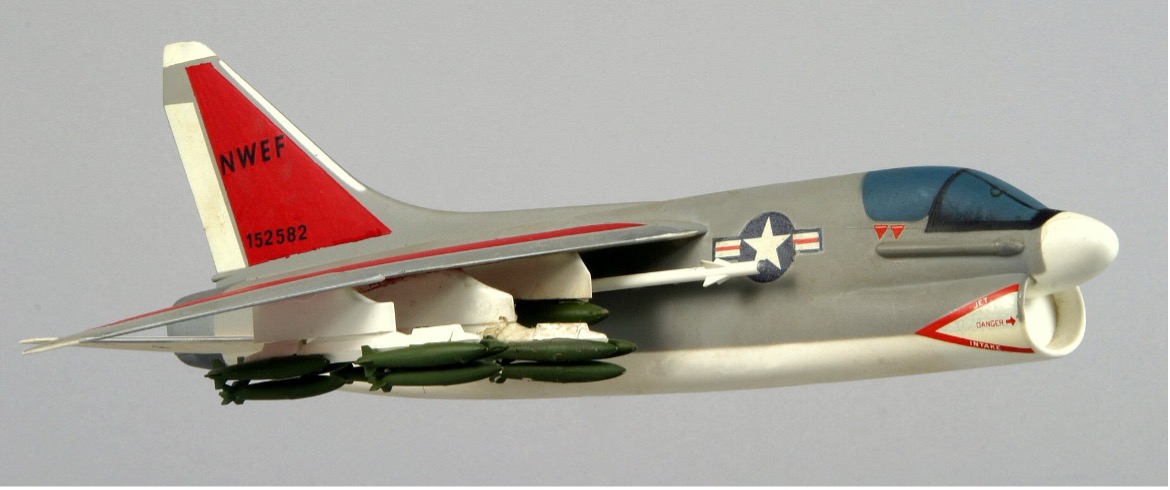USN NWEF Ling-Temco-Vought A-7A Corsair II

MODEL BY:
H. Davidson
Model Scale:
1/48
MODEL ADDED:
11/14/1966
historical significance
First Albuquerque Visit: 1966
Additional Information:
The Ling-Temco-Vought A-7 Corsair II is an American carrier-capable subsonic light attack aircraft designed and manufactured by Ling-Temco-Vought (LTV). The A-7 was developed during the early 1960s as replacement for the Douglas A-4 Skyhawk. The A-7’s design was derived from the Vought F-8 Crusader. Compared to the F-8, the A-7 is a smaller, simpler, and cheaper airframe to produce. The initial contract for the A-7 was issued on February 8, 1964 and the development progressed quickly with the first model flying on September 26, 1965.
The A-7 entered service with the United States Navy (USN) on February 1, 1967 and was soon after deployed overseas for the Vietnam War. The A-7 soon proved attractive to other services and was quickly adopted by the United States Air Force (USAF) and the Air National Guard (ANG) to replace the aging Douglas A-1 Skyraider and North American F-100 Super Sabre fleets.
Albuquerque’s Kirtland Field was designated Kirtland Air Force Base in 1947, and the Armed Forces Special Weapons Project (AFSWP) operated on Sandia Base. When the United States Air Force established the Air Force Special Weapons Command at Kirtland Air Force Base in 1949, the United States Navy formed a detachment to investigate nuclear capabilities for naval aircraft and assist the AFSWP with naval equipment for demonstrations and training. The Naval Weapons Evaluation Facility (NWEF) operated through the Cold War investigating aircraft-weapon interfaces to provide United States Navy aircraft with nuclear weapons delivery capability.
In 1952 this detachment was designated the Naval Air Special Weapons Facility (NASWF) to conduct special weapons tests on the White Sands Missile Range and Tonopah Test Range in coordination with the United States Atomic Energy Commission. In March of 1961, the NASWF was re-designated the Naval Weapons Evaluation Facility (NWEF) and its mission was expanded to include safety studies on nuclear weapons. The aircraft used for NWEF testing were decorated with the NWEF thunderbird symbol and the NWEF detachment became known as the Rio Grande Navy by its sailors and civilians.
In 1992, with the consolidation of many naval activities and the drawdown of the U.S. defense budget, NWEF became part of the large, multisite Naval Air Warfare Center Weapons Division in China Lake. In 1993 the NWEF was decommissioned and became the first nuclear-weapons-related facility in the Free World to be shut down. As NWEF closed, it transferred some of its remaining people and functions to the China Lake site.
On September 13, 1966, a prototype of the Ling-Temco-Vought A-7 Corsair II, Bu No. 152582, was assigned to the Naval Weapons Evaluation Facility (NWEF) on Kirtland Air Force Base in Albuquerque, New Mexico, for special weapons evaluation tests.
The A-7D model was used to replace the F-100s of the New Mexico Air National Guard (NMANG) in 1973.
The USN by the mid 1980’s had 22 squadrons using the A-7E’s in the entire fleet.
A second Corsair II A-7A was used for electronic testing on the all-wood TRESTLE facility.
A two seat version of the A-7 was made for training and one of the aircraft was photographed on Kirtland AFB.
GALLERY:
SEARCH OUR DATABASE:
